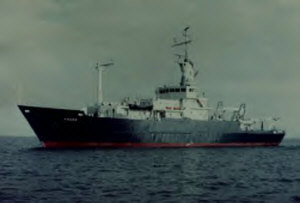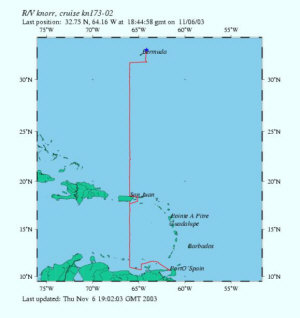"Titanic" Accomplishment of Bay City Built Ship Noted at History Conference
Museum's Video Highlights Fabulous Maritime History of Saginaw River
November 9, 2003
By: Dave Rogers

Defoe-built Research Vessel Knorr was lengthened from 244 to 279 feet in 1989-91.

Up to date location of Knorr can be accessed at Woods Hole Oceanographic Institute website. Map shows location as of Nov. 6 near Bermuda.
One of the momentous accomplishments in Bay City maritime history occurred in 1985 when the U.S. Navy Research Vessel Knorr discovered the wreckage of the steamship Titanic two and a half miles below the surface of the Atlantic Ocean.
This little-known event is a small part of the video documentary that is featured in the maritime gallery of the Bay County Historical Museum. The video was part of a presentation by Ron Bloomfield, curator of collections and research, Bay County Historical Society, on Saturday, Nov. 8, at the 28th Annual Great Lakes History Conference in Grand Rapids.
The Knorr, 244 feet long, was launched in 1968 at the Defoe Shipbuilding Co. and is one of hundreds of vessels built by the local firm for the U.S. Government. The Research Vessel Knorr is a US Navy-owned ship operated by the Woods Hole Oceanographic Institution (WHOI) for the ocean research community. Launched in 1968, delivered to WHOI in 1970 and completing a major overhaul in 1991, R/V Knorr has traveledover the world's oceans to conduct oceanographic research in biology, chemistry, geology and geophysics, physical oceanography, and ocean engineering. It is equipped with sophisticated navigation and communication systems and can accommodate a wide variety of scientific projects.
R/V Knorr is named in honor of Ernest R. Knorr, a distinguished early hydrographic engineer and cartographer, who was appointed senior civilian and Chief Engineer Cartographer of the US Navy Hydrographic Office in 1860.
Mr. Knorr was largely responsible for the success of the Navy's first systematic charting and surveying effort from 1860 to 1885.
This narrative of the discovery is from the official Titanic website:
"RECOVERY: TITANIC FOUND""For two weeks, the French and American team surveyed the target area, using the Americans' video search capabilities. Then, on September 1, 1985, at 1:05 a.m., IFREMER's Jean-Louis Michel was on duty, watching the video monitor on the Knorr, when images of huge metal boilers, steel plating, railings and portholes began to appear on the screen. Michel knew that they had at last found the Titanic, and shortly before 2:00 a.m. he sent a crew member to awaken Robert Ballard, who was sleeping in his cabin. The crew of the Knorr then spontaneously gathered on the vessel's stern and raised the Harland and Wolff flag in memory of the Titanic and the disaster's victims."
Dr. Jerry Foust, Loyola University History professor, was chair/commentator of the session "Michigan Ports and the Great Lakes" that featured Bloomfield's presentation, "Legends, Logs and Launches: Saginaw River Past and Present." The presentation was highlighted by the showing of the video documentary that is featured in the maritime gallery of the Bay County Historical Museum.
Each time I see this documentary, I am more impressed by Bloomfield's research and the video work of Ric Mixter, former WNEM-TV 5 news broadcaster, now with his own Airworthy Productions, of Saginaw.
Obviously, others who saw the video and reviewed the museum's programs were also impressed, leading to the 2001 Certificate of Commendation for Excellence in the museum field. It was the only such award made in the state and one of only a handful nationally that year.
"This was proof we were able to do something worthwhile," said Bloomfield.
The video incorporates historic film footage and includes interviews with local and national level historians and local marine figures. These include Jack Wirt, of Wirt Stone Docks; Don Comtois, of the Saginaw River Marine Historical Society; David Cooper, University of Wisconsin marine archaeologist; and Brad Rodgers, marine researcher of East Carolina University.
Dr. Foust said the history of Michgan's harbor scapes is "woefully underdeveloped" even though it is vitally important to Michigan's political and social history.
Bay City's history is the equal of any on the Great Lakes dating back to prehistoric days when the area had the largest native population in the state. Historians are still trying to locate Skull Island, where early settlers found piles of human remains from two centuries before.
Lumber, said to be the best ever harvested in the United States, brought thousands of lumberjacks and river hogs to Bay City's infamous "Hell's Half Mile" each spring. The epicenter was the Catacombs area, with 24 saloons and scores of prostitutes along Water, Saginaw and Third streets.
Saginaw and Bay City, with 100 mills lining the river between them, overshadowed Muskegon, which claimed to be "Queen of the Lumber Trade," but had only 47 mills at the height of the trade, the mid-1880s.
Vast forests of oak and tamarack brought such titans as Capt. James Davidson, who built his "Goliaths," the largest wooden ships in the world, along the Saginaw River from 1871 until 1900.
Comtois tells of the 15-year-old Bay City boy who devised the world's first range light system by hoisting lanterns on planks at the mouth of the Saginaw River. Similar systems are still used worldwide today.
Jack Wirt, a marine-centered businessman, tells how he rescued previously-discarded limestone chips from being dumped in the lake and built a substantialtrade in crushed limestone. A ship bearing his name traversed the lakes for many years.
The fabulous shipbuilding history of Bay City would not be complete without telling of the Frank Wheeler yard, which produced 157 vessels, including the famed steamer Daniel J. Morrell, sunk in a storm in 1966; and Harry J. Defoe's company which built a prototype subchaser for the U.S. Navy in World War II and won the Navy's "E" award for excellence. Defoe's yacht built for Sewell Avery, most popularly known as the Presidential Yacht "Honey Fitz," may be returned as a tourism attraction here if a group of local promoters are able to raise the funds to acquire and display it on the riverfront.
The list of Bay City's history highlights goes on and on, including Hilda Mueller, who in 1930 became the only woman to win a national outboard motor boat racing title.
If you haven't seen the maritime gallery at the Bay County Historical Museum, you should go and view the video which documents so many historic maritime events and personalities.
As Dr. Foust said: "The maritime history of Michigan is what made the area of national importance. More needs to be understood about this era. The question is: Can we learn from the past to better our lives in the future?"
EDITOR'S NOTE: Readers interested in more information about the discovery of the Titanic, and the R/V Knorr, may access
www.titanic-titanic.com/ or
www.whoi.edu.